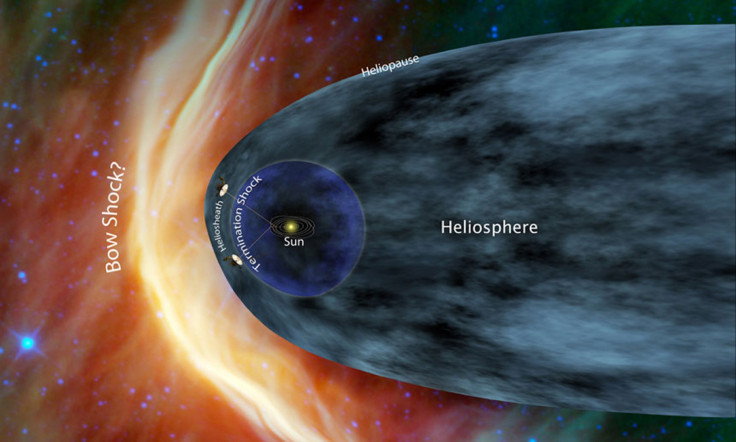NASA's Voyager 1 Set To Become 'Humankind's Most Distant Scout,' Will Leave Solar System To Enter Interstellar Space

NASA’s Voyager 1 spacecraft, which is currently more than 11 billion miles from the sun, is set to leave our solar system to cross the threshold of interstellar space.
Voyager 1 will cross a region in our solar system’s edge, called the magnetic highway, before leaving the heliosphere to enter interstellar space, a NASA research report, based on data collected from Voyager 1, said. A signal from Voyager 1 takes approximately 17 hours to travel to Earth.
The heliosphere, filled with a magnetic field and hot ionized gas, or plasma, emanating directly from the sun, extends at least 8 billion miles beyond all the planets in our solar system. Although scientists are still uncertain about the distance that Voyager 1 has to cover to reach interstellar space, they believe it will not take too long. Measuring the heliosphere’s size is also a part of the spacecraft’s mission.
According to scientists’ estimates, it could take the spacecraft several more months, or even years, to enter interstellar space, which is dominated by matter from other stars and the magnetic field present in the nearby region of our Milky Way Galaxy.
The research, published in the journal Science on Thursday, explained how Voyager 1’s entry into the edge of the sun’s territory simultaneously provides details about charged particles from outside the heliosphere and the disappearance of charged particles from inside it.
There are three major signs, scientists say, which would indicate the presence of the interstellar magnetic field. Scientist have observed two so far -- charged particles vanishing as they zoom out along the solar magnetic field and cosmic rays zooming in from far outside -- while the third sign, a sudden change in the direction of the magnetic field, is yet to be spotted.
Scientists said that they have never witnessed such a dramatic and rapid disappearance of the solar-originating particles before. Decreasing in intensity by more than 1,000 times, the disappearing particles have acted as if there was a huge vacuum pump at the entrance of the magnetic highway.
"If you looked at the cosmic ray and energetic particle data in isolation, you might think Voyager had reached interstellar space, but the team feels Voyager 1 has not yet gotten there because we are still within the domain of the sun's magnetic field,” Ed Stone, Voyager project scientist at the California Institute of Technology, in Pasadena, said in a statement, calling Voyager 1 “humankind's most distant scout” ever.
Voyager 1 and Voyager 2 were launched 16 days apart in 1977. Both spacecrafts toured Jupiter, Saturn, Uranus and Neptune prior to kicking off the interstellar mission in 1990. While Voyager 1 is the most distant human-made object, Voyager 2 is the longest continuously operated spacecraft, functioning about nine billion miles away from the sun.
Scientists estimate that both Voyager 1 and Voyager 2 will have enough electrical power to continue collecting data and communicating them back to Earth through 2020, and possibly, through 2025.
For updates on the Voyager spacecrafts' current locations, click here.
© Copyright IBTimes 2025. All rights reserved.




















